HI6008 Semester 1/2018: Cyber Security Challenges Literature Review
VerifiedAdded on 2023/06/12
|16
|4274
|425
Literature Review
AI Summary
This literature review examines the challenges of cyber security in business, focusing on the impact of cyber threats on business organizations. It identifies various cyber security issues such as malware, lack of cyber security policies, BYOD (Bring Your Own Device) issues, absence of recovery plans, lack of security training, and problems in covering cyber security basics. The review further discusses the economic costs, reputational damage, and legal consequences of cyber attacks on businesses. It also explores potential cyber security options and mitigation strategies. This assignment is available on Desklib, a platform offering a range of study tools and resources for students.
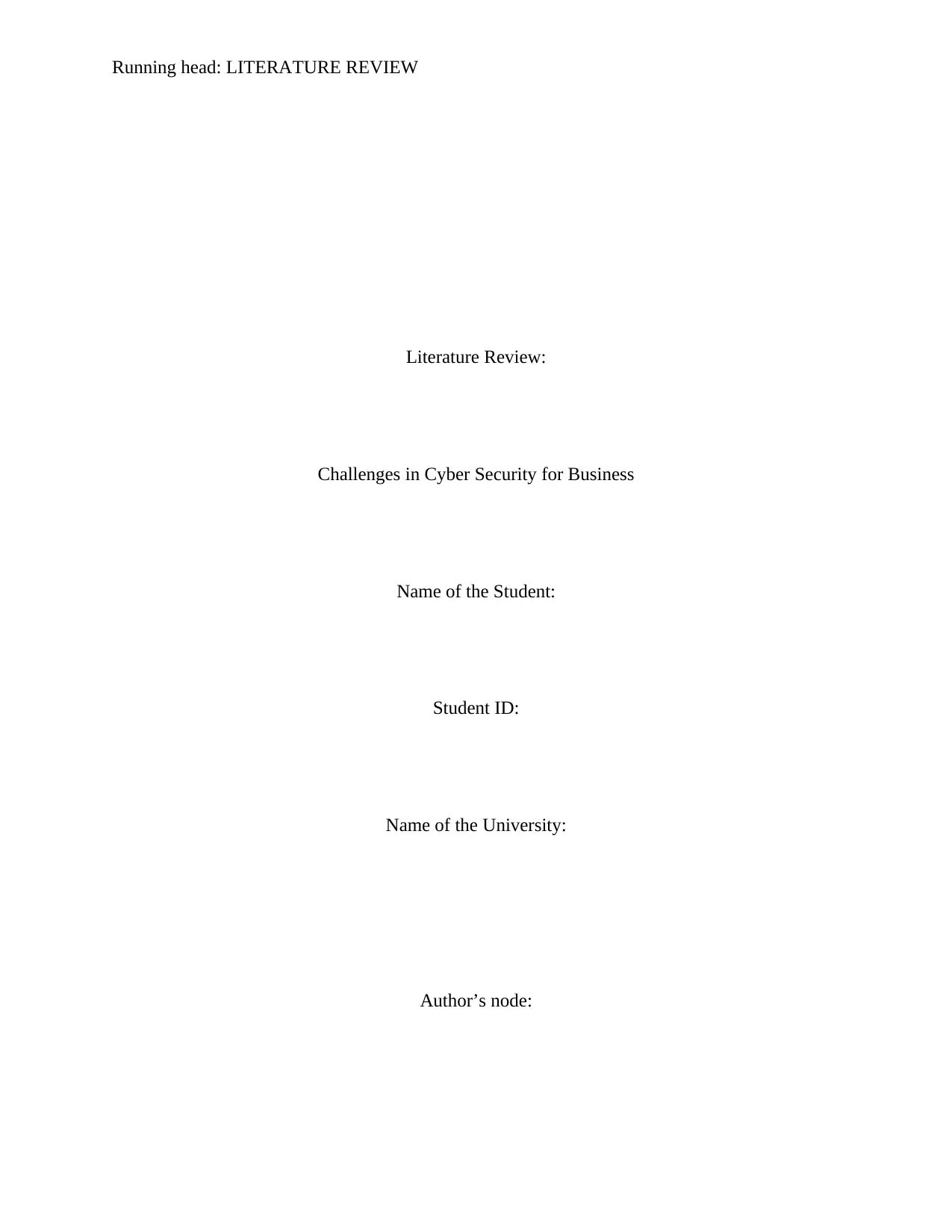
Running head: LITERATURE REVIEW
Literature Review:
Challenges in Cyber Security for Business
Name of the Student:
Student ID:
Name of the University:
Author’s node:
Literature Review:
Challenges in Cyber Security for Business
Name of the Student:
Student ID:
Name of the University:
Author’s node:
Paraphrase This Document
Need a fresh take? Get an instant paraphrase of this document with our AI Paraphraser
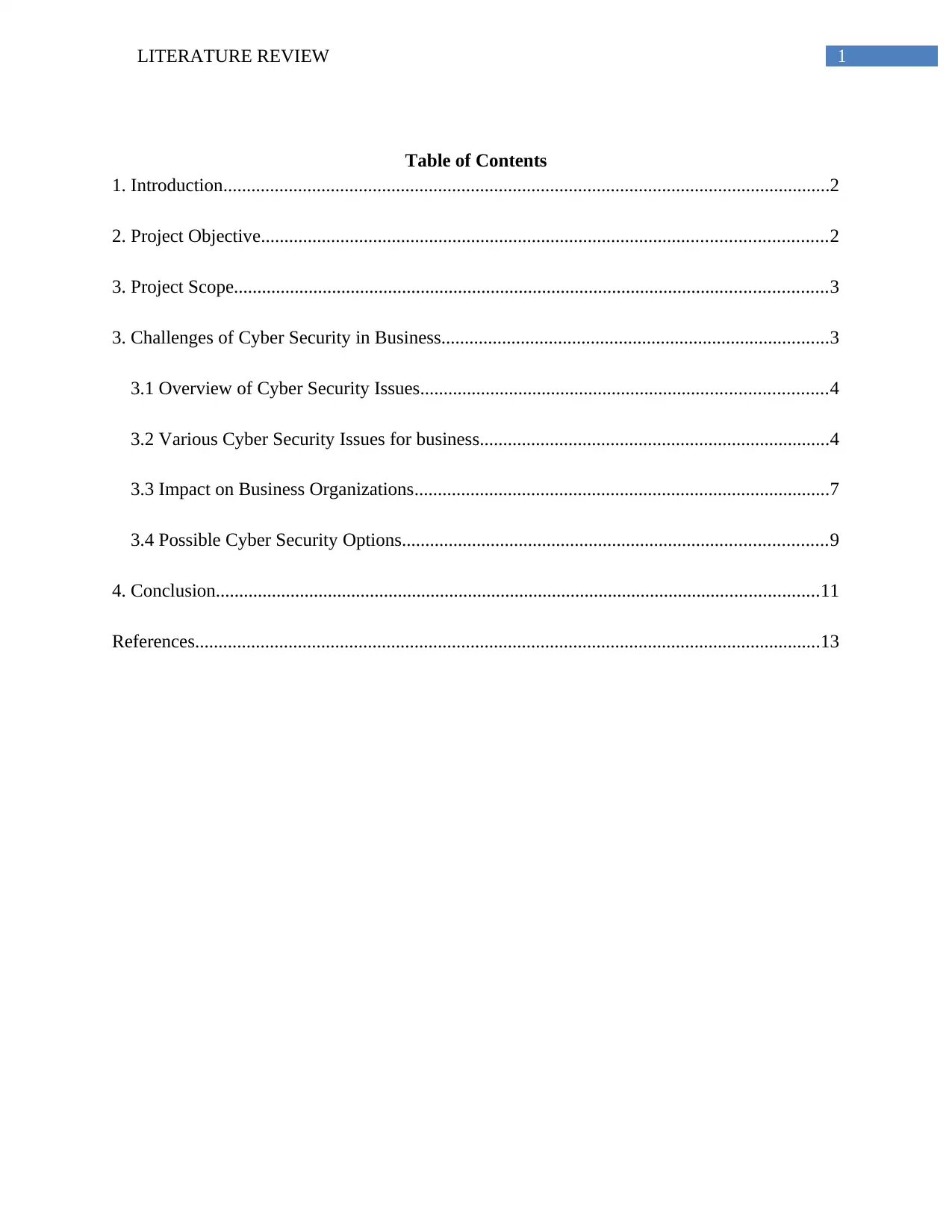
1LITERATURE REVIEW
Table of Contents
1. Introduction..................................................................................................................................2
2. Project Objective.........................................................................................................................2
3. Project Scope...............................................................................................................................3
3. Challenges of Cyber Security in Business...................................................................................3
3.1 Overview of Cyber Security Issues.......................................................................................4
3.2 Various Cyber Security Issues for business...........................................................................4
3.3 Impact on Business Organizations.........................................................................................7
3.4 Possible Cyber Security Options...........................................................................................9
4. Conclusion.................................................................................................................................11
References......................................................................................................................................13
Table of Contents
1. Introduction..................................................................................................................................2
2. Project Objective.........................................................................................................................2
3. Project Scope...............................................................................................................................3
3. Challenges of Cyber Security in Business...................................................................................3
3.1 Overview of Cyber Security Issues.......................................................................................4
3.2 Various Cyber Security Issues for business...........................................................................4
3.3 Impact on Business Organizations.........................................................................................7
3.4 Possible Cyber Security Options...........................................................................................9
4. Conclusion.................................................................................................................................11
References......................................................................................................................................13
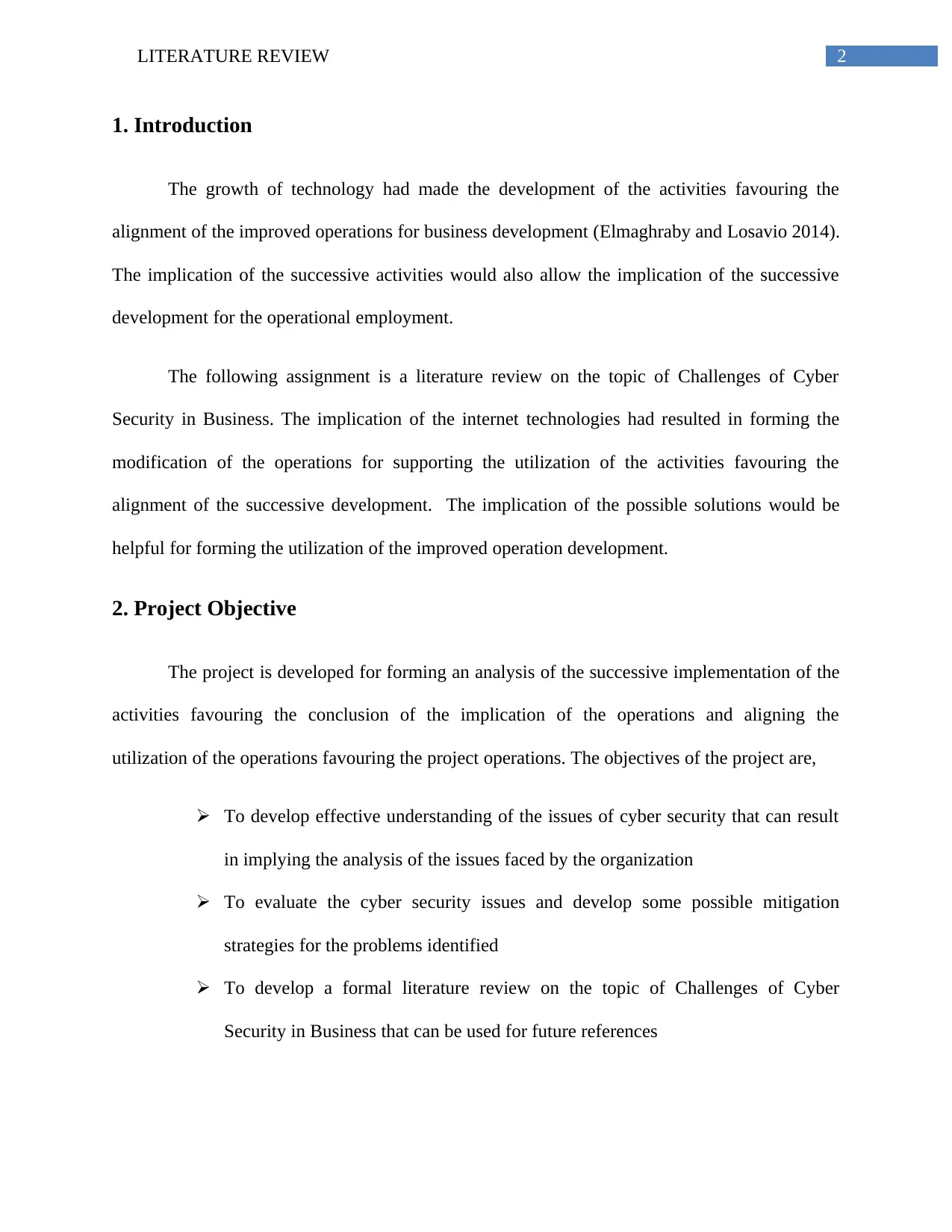
2LITERATURE REVIEW
1. Introduction
The growth of technology had made the development of the activities favouring the
alignment of the improved operations for business development (Elmaghraby and Losavio 2014).
The implication of the successive activities would also allow the implication of the successive
development for the operational employment.
The following assignment is a literature review on the topic of Challenges of Cyber
Security in Business. The implication of the internet technologies had resulted in forming the
modification of the operations for supporting the utilization of the activities favouring the
alignment of the successive development. The implication of the possible solutions would be
helpful for forming the utilization of the improved operation development.
2. Project Objective
The project is developed for forming an analysis of the successive implementation of the
activities favouring the conclusion of the implication of the operations and aligning the
utilization of the operations favouring the project operations. The objectives of the project are,
To develop effective understanding of the issues of cyber security that can result
in implying the analysis of the issues faced by the organization
To evaluate the cyber security issues and develop some possible mitigation
strategies for the problems identified
To develop a formal literature review on the topic of Challenges of Cyber
Security in Business that can be used for future references
1. Introduction
The growth of technology had made the development of the activities favouring the
alignment of the improved operations for business development (Elmaghraby and Losavio 2014).
The implication of the successive activities would also allow the implication of the successive
development for the operational employment.
The following assignment is a literature review on the topic of Challenges of Cyber
Security in Business. The implication of the internet technologies had resulted in forming the
modification of the operations for supporting the utilization of the activities favouring the
alignment of the successive development. The implication of the possible solutions would be
helpful for forming the utilization of the improved operation development.
2. Project Objective
The project is developed for forming an analysis of the successive implementation of the
activities favouring the conclusion of the implication of the operations and aligning the
utilization of the operations favouring the project operations. The objectives of the project are,
To develop effective understanding of the issues of cyber security that can result
in implying the analysis of the issues faced by the organization
To evaluate the cyber security issues and develop some possible mitigation
strategies for the problems identified
To develop a formal literature review on the topic of Challenges of Cyber
Security in Business that can be used for future references
⊘ This is a preview!⊘
Do you want full access?
Subscribe today to unlock all pages.

Trusted by 1+ million students worldwide
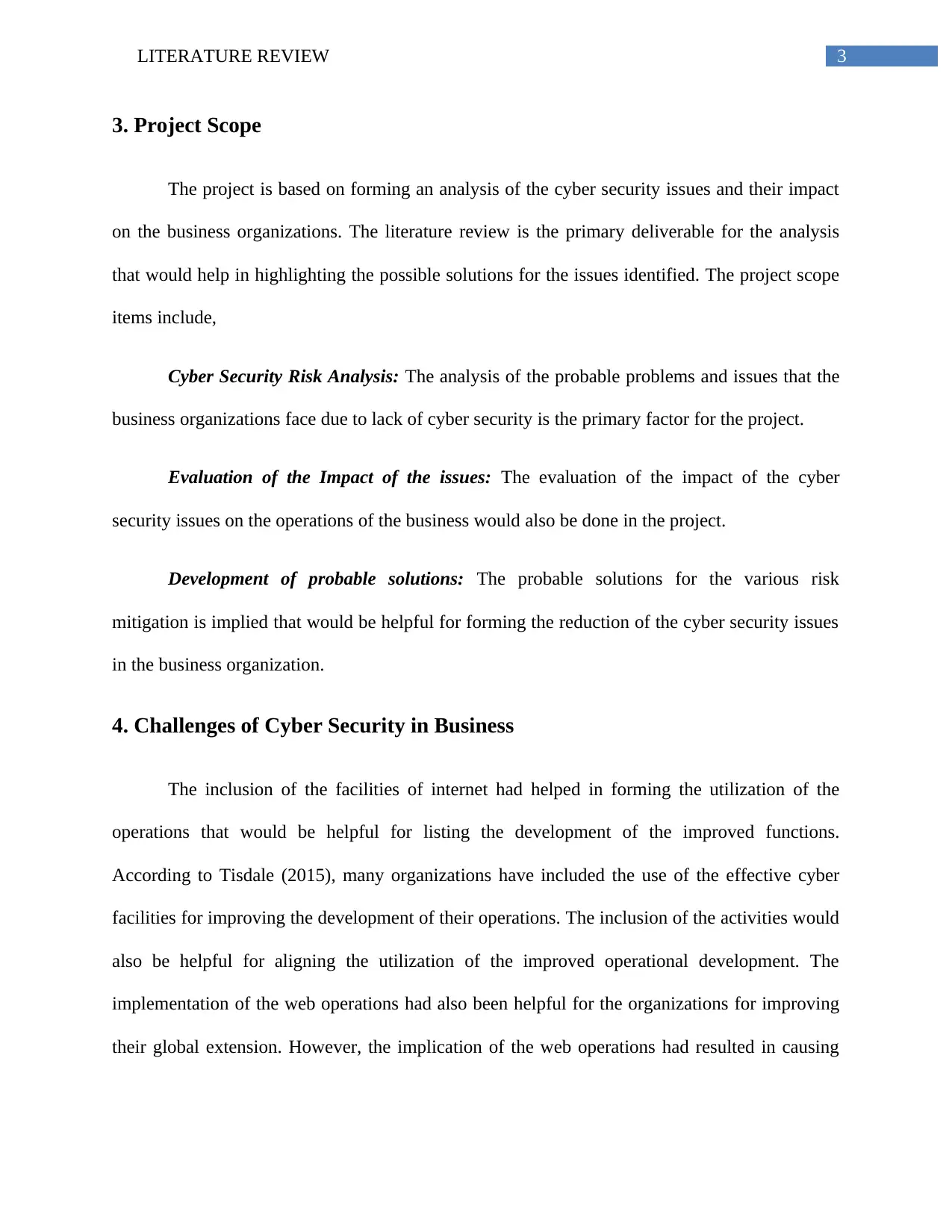
3LITERATURE REVIEW
3. Project Scope
The project is based on forming an analysis of the cyber security issues and their impact
on the business organizations. The literature review is the primary deliverable for the analysis
that would help in highlighting the possible solutions for the issues identified. The project scope
items include,
Cyber Security Risk Analysis: The analysis of the probable problems and issues that the
business organizations face due to lack of cyber security is the primary factor for the project.
Evaluation of the Impact of the issues: The evaluation of the impact of the cyber
security issues on the operations of the business would also be done in the project.
Development of probable solutions: The probable solutions for the various risk
mitigation is implied that would be helpful for forming the reduction of the cyber security issues
in the business organization.
4. Challenges of Cyber Security in Business
The inclusion of the facilities of internet had helped in forming the utilization of the
operations that would be helpful for listing the development of the improved functions.
According to Tisdale (2015), many organizations have included the use of the effective cyber
facilities for improving the development of their operations. The inclusion of the activities would
also be helpful for aligning the utilization of the improved operational development. The
implementation of the web operations had also been helpful for the organizations for improving
their global extension. However, the implication of the web operations had resulted in causing
3. Project Scope
The project is based on forming an analysis of the cyber security issues and their impact
on the business organizations. The literature review is the primary deliverable for the analysis
that would help in highlighting the possible solutions for the issues identified. The project scope
items include,
Cyber Security Risk Analysis: The analysis of the probable problems and issues that the
business organizations face due to lack of cyber security is the primary factor for the project.
Evaluation of the Impact of the issues: The evaluation of the impact of the cyber
security issues on the operations of the business would also be done in the project.
Development of probable solutions: The probable solutions for the various risk
mitigation is implied that would be helpful for forming the reduction of the cyber security issues
in the business organization.
4. Challenges of Cyber Security in Business
The inclusion of the facilities of internet had helped in forming the utilization of the
operations that would be helpful for listing the development of the improved functions.
According to Tisdale (2015), many organizations have included the use of the effective cyber
facilities for improving the development of their operations. The inclusion of the activities would
also be helpful for aligning the utilization of the improved operational development. The
implementation of the web operations had also been helpful for the organizations for improving
their global extension. However, the implication of the web operations had resulted in causing
Paraphrase This Document
Need a fresh take? Get an instant paraphrase of this document with our AI Paraphraser
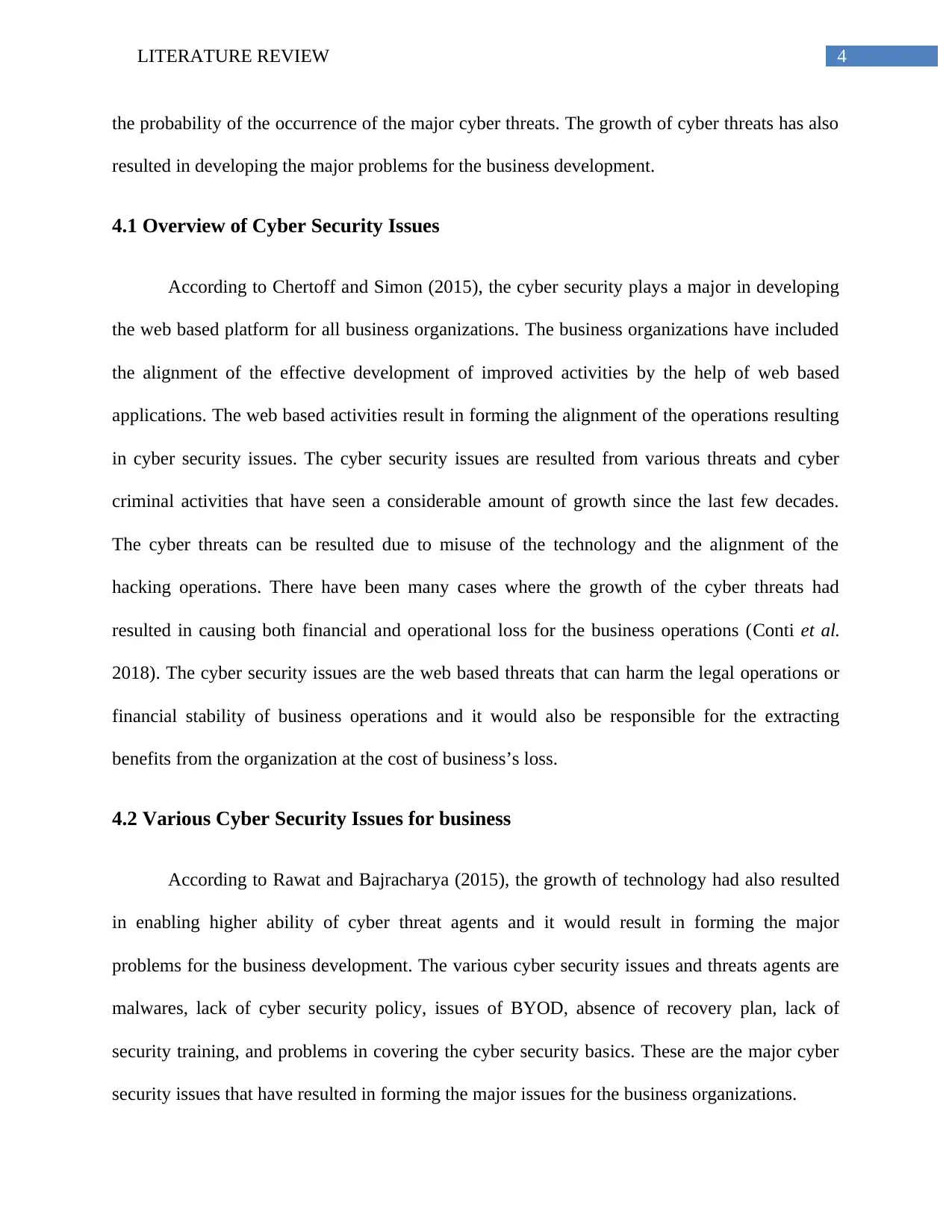
4LITERATURE REVIEW
the probability of the occurrence of the major cyber threats. The growth of cyber threats has also
resulted in developing the major problems for the business development.
4.1 Overview of Cyber Security Issues
According to Chertoff and Simon (2015), the cyber security plays a major in developing
the web based platform for all business organizations. The business organizations have included
the alignment of the effective development of improved activities by the help of web based
applications. The web based activities result in forming the alignment of the operations resulting
in cyber security issues. The cyber security issues are resulted from various threats and cyber
criminal activities that have seen a considerable amount of growth since the last few decades.
The cyber threats can be resulted due to misuse of the technology and the alignment of the
hacking operations. There have been many cases where the growth of the cyber threats had
resulted in causing both financial and operational loss for the business operations (Conti et al.
2018). The cyber security issues are the web based threats that can harm the legal operations or
financial stability of business operations and it would also be responsible for the extracting
benefits from the organization at the cost of business’s loss.
4.2 Various Cyber Security Issues for business
According to Rawat and Bajracharya (2015), the growth of technology had also resulted
in enabling higher ability of cyber threat agents and it would result in forming the major
problems for the business development. The various cyber security issues and threats agents are
malwares, lack of cyber security policy, issues of BYOD, absence of recovery plan, lack of
security training, and problems in covering the cyber security basics. These are the major cyber
security issues that have resulted in forming the major issues for the business organizations.
the probability of the occurrence of the major cyber threats. The growth of cyber threats has also
resulted in developing the major problems for the business development.
4.1 Overview of Cyber Security Issues
According to Chertoff and Simon (2015), the cyber security plays a major in developing
the web based platform for all business organizations. The business organizations have included
the alignment of the effective development of improved activities by the help of web based
applications. The web based activities result in forming the alignment of the operations resulting
in cyber security issues. The cyber security issues are resulted from various threats and cyber
criminal activities that have seen a considerable amount of growth since the last few decades.
The cyber threats can be resulted due to misuse of the technology and the alignment of the
hacking operations. There have been many cases where the growth of the cyber threats had
resulted in causing both financial and operational loss for the business operations (Conti et al.
2018). The cyber security issues are the web based threats that can harm the legal operations or
financial stability of business operations and it would also be responsible for the extracting
benefits from the organization at the cost of business’s loss.
4.2 Various Cyber Security Issues for business
According to Rawat and Bajracharya (2015), the growth of technology had also resulted
in enabling higher ability of cyber threat agents and it would result in forming the major
problems for the business development. The various cyber security issues and threats agents are
malwares, lack of cyber security policy, issues of BYOD, absence of recovery plan, lack of
security training, and problems in covering the cyber security basics. These are the major cyber
security issues that have resulted in forming the major issues for the business organizations.
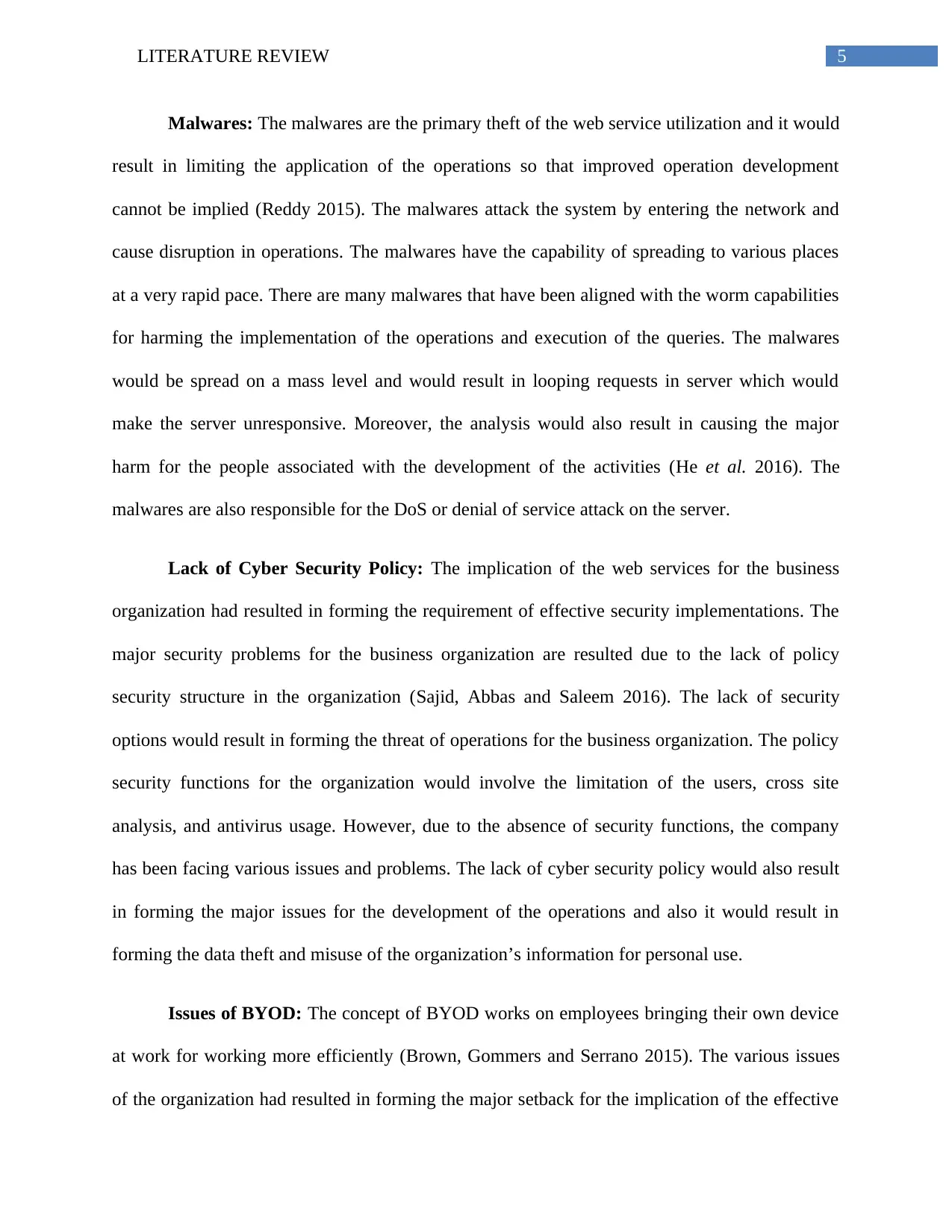
5LITERATURE REVIEW
Malwares: The malwares are the primary theft of the web service utilization and it would
result in limiting the application of the operations so that improved operation development
cannot be implied (Reddy 2015). The malwares attack the system by entering the network and
cause disruption in operations. The malwares have the capability of spreading to various places
at a very rapid pace. There are many malwares that have been aligned with the worm capabilities
for harming the implementation of the operations and execution of the queries. The malwares
would be spread on a mass level and would result in looping requests in server which would
make the server unresponsive. Moreover, the analysis would also result in causing the major
harm for the people associated with the development of the activities (He et al. 2016). The
malwares are also responsible for the DoS or denial of service attack on the server.
Lack of Cyber Security Policy: The implication of the web services for the business
organization had resulted in forming the requirement of effective security implementations. The
major security problems for the business organization are resulted due to the lack of policy
security structure in the organization (Sajid, Abbas and Saleem 2016). The lack of security
options would result in forming the threat of operations for the business organization. The policy
security functions for the organization would involve the limitation of the users, cross site
analysis, and antivirus usage. However, due to the absence of security functions, the company
has been facing various issues and problems. The lack of cyber security policy would also result
in forming the major issues for the development of the operations and also it would result in
forming the data theft and misuse of the organization’s information for personal use.
Issues of BYOD: The concept of BYOD works on employees bringing their own device
at work for working more efficiently (Brown, Gommers and Serrano 2015). The various issues
of the organization had resulted in forming the major setback for the implication of the effective
Malwares: The malwares are the primary theft of the web service utilization and it would
result in limiting the application of the operations so that improved operation development
cannot be implied (Reddy 2015). The malwares attack the system by entering the network and
cause disruption in operations. The malwares have the capability of spreading to various places
at a very rapid pace. There are many malwares that have been aligned with the worm capabilities
for harming the implementation of the operations and execution of the queries. The malwares
would be spread on a mass level and would result in looping requests in server which would
make the server unresponsive. Moreover, the analysis would also result in causing the major
harm for the people associated with the development of the activities (He et al. 2016). The
malwares are also responsible for the DoS or denial of service attack on the server.
Lack of Cyber Security Policy: The implication of the web services for the business
organization had resulted in forming the requirement of effective security implementations. The
major security problems for the business organization are resulted due to the lack of policy
security structure in the organization (Sajid, Abbas and Saleem 2016). The lack of security
options would result in forming the threat of operations for the business organization. The policy
security functions for the organization would involve the limitation of the users, cross site
analysis, and antivirus usage. However, due to the absence of security functions, the company
has been facing various issues and problems. The lack of cyber security policy would also result
in forming the major issues for the development of the operations and also it would result in
forming the data theft and misuse of the organization’s information for personal use.
Issues of BYOD: The concept of BYOD works on employees bringing their own device
at work for working more efficiently (Brown, Gommers and Serrano 2015). The various issues
of the organization had resulted in forming the major setback for the implication of the effective
⊘ This is a preview!⊘
Do you want full access?
Subscribe today to unlock all pages.

Trusted by 1+ million students worldwide
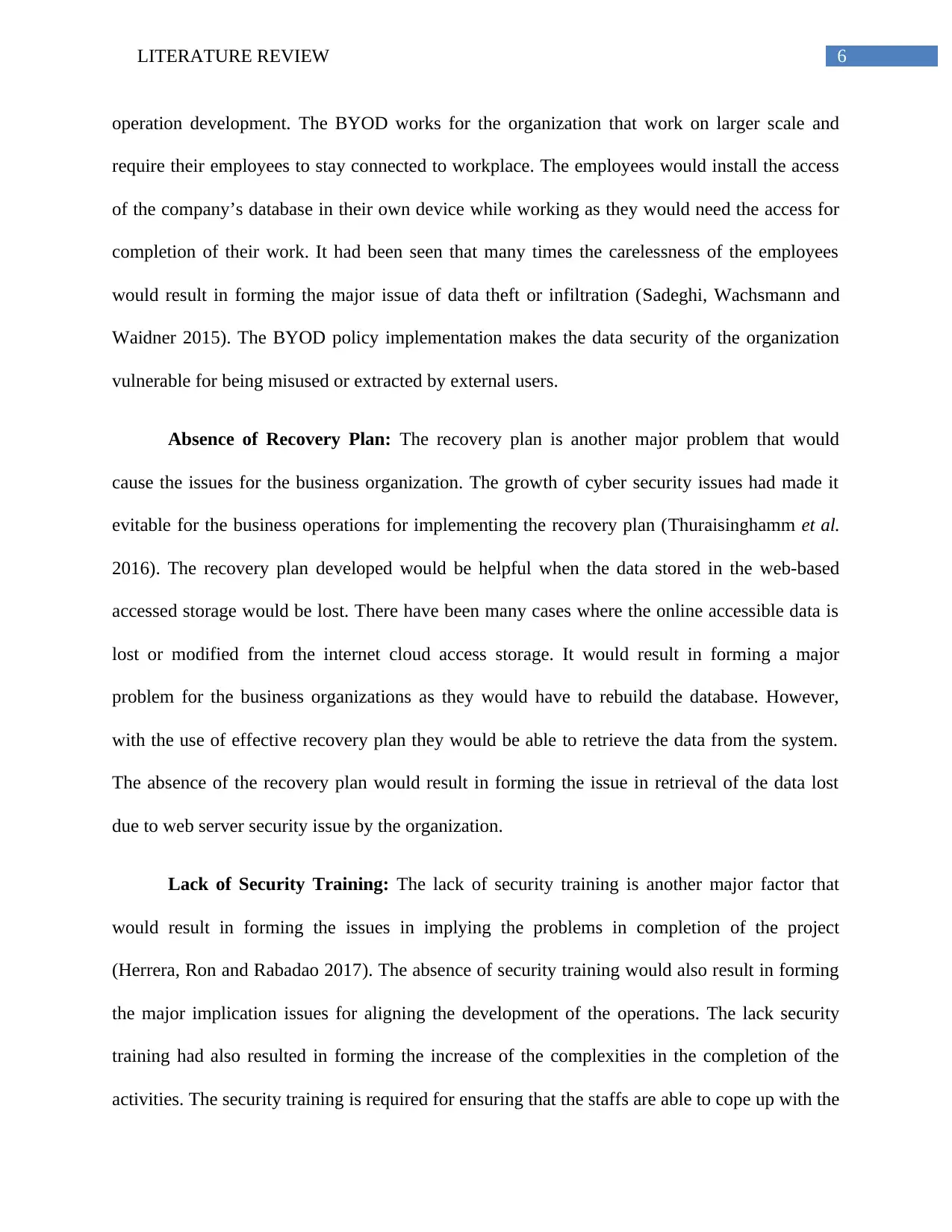
6LITERATURE REVIEW
operation development. The BYOD works for the organization that work on larger scale and
require their employees to stay connected to workplace. The employees would install the access
of the company’s database in their own device while working as they would need the access for
completion of their work. It had been seen that many times the carelessness of the employees
would result in forming the major issue of data theft or infiltration (Sadeghi, Wachsmann and
Waidner 2015). The BYOD policy implementation makes the data security of the organization
vulnerable for being misused or extracted by external users.
Absence of Recovery Plan: The recovery plan is another major problem that would
cause the issues for the business organization. The growth of cyber security issues had made it
evitable for the business operations for implementing the recovery plan (Thuraisinghamm et al.
2016). The recovery plan developed would be helpful when the data stored in the web-based
accessed storage would be lost. There have been many cases where the online accessible data is
lost or modified from the internet cloud access storage. It would result in forming a major
problem for the business organizations as they would have to rebuild the database. However,
with the use of effective recovery plan they would be able to retrieve the data from the system.
The absence of the recovery plan would result in forming the issue in retrieval of the data lost
due to web server security issue by the organization.
Lack of Security Training: The lack of security training is another major factor that
would result in forming the issues in implying the problems in completion of the project
(Herrera, Ron and Rabadao 2017). The absence of security training would also result in forming
the major implication issues for aligning the development of the operations. The lack security
training had also resulted in forming the increase of the complexities in the completion of the
activities. The security training is required for ensuring that the staffs are able to cope up with the
operation development. The BYOD works for the organization that work on larger scale and
require their employees to stay connected to workplace. The employees would install the access
of the company’s database in their own device while working as they would need the access for
completion of their work. It had been seen that many times the carelessness of the employees
would result in forming the major issue of data theft or infiltration (Sadeghi, Wachsmann and
Waidner 2015). The BYOD policy implementation makes the data security of the organization
vulnerable for being misused or extracted by external users.
Absence of Recovery Plan: The recovery plan is another major problem that would
cause the issues for the business organization. The growth of cyber security issues had made it
evitable for the business operations for implementing the recovery plan (Thuraisinghamm et al.
2016). The recovery plan developed would be helpful when the data stored in the web-based
accessed storage would be lost. There have been many cases where the online accessible data is
lost or modified from the internet cloud access storage. It would result in forming a major
problem for the business organizations as they would have to rebuild the database. However,
with the use of effective recovery plan they would be able to retrieve the data from the system.
The absence of the recovery plan would result in forming the issue in retrieval of the data lost
due to web server security issue by the organization.
Lack of Security Training: The lack of security training is another major factor that
would result in forming the issues in implying the problems in completion of the project
(Herrera, Ron and Rabadao 2017). The absence of security training would also result in forming
the major implication issues for aligning the development of the operations. The lack security
training had also resulted in forming the increase of the complexities in the completion of the
activities. The security training is required for ensuring that the staffs are able to cope up with the
Paraphrase This Document
Need a fresh take? Get an instant paraphrase of this document with our AI Paraphraser
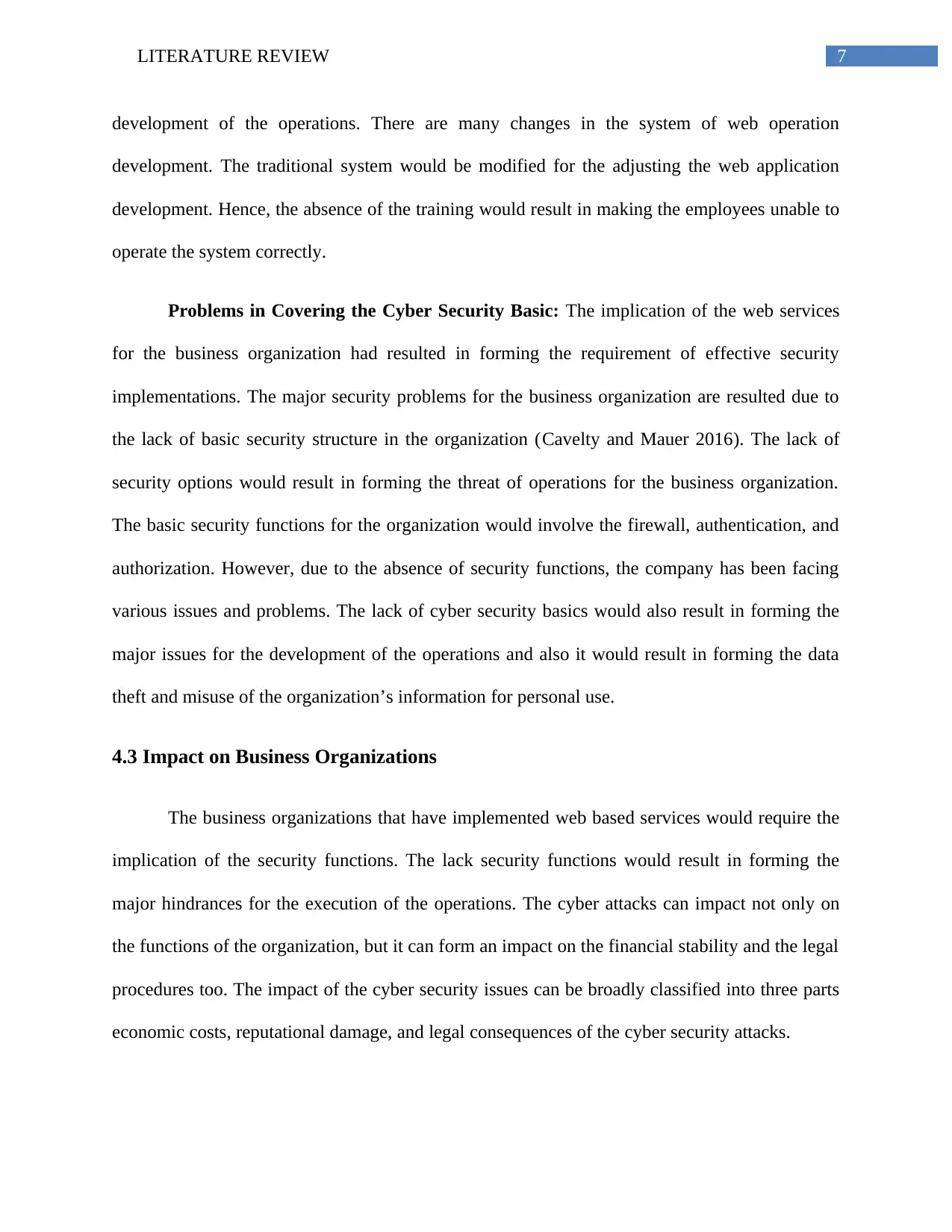
7LITERATURE REVIEW
development of the operations. There are many changes in the system of web operation
development. The traditional system would be modified for the adjusting the web application
development. Hence, the absence of the training would result in making the employees unable to
operate the system correctly.
Problems in Covering the Cyber Security Basic: The implication of the web services
for the business organization had resulted in forming the requirement of effective security
implementations. The major security problems for the business organization are resulted due to
the lack of basic security structure in the organization (Cavelty and Mauer 2016). The lack of
security options would result in forming the threat of operations for the business organization.
The basic security functions for the organization would involve the firewall, authentication, and
authorization. However, due to the absence of security functions, the company has been facing
various issues and problems. The lack of cyber security basics would also result in forming the
major issues for the development of the operations and also it would result in forming the data
theft and misuse of the organization’s information for personal use.
4.3 Impact on Business Organizations
The business organizations that have implemented web based services would require the
implication of the security functions. The lack security functions would result in forming the
major hindrances for the execution of the operations. The cyber attacks can impact not only on
the functions of the organization, but it can form an impact on the financial stability and the legal
procedures too. The impact of the cyber security issues can be broadly classified into three parts
economic costs, reputational damage, and legal consequences of the cyber security attacks.
development of the operations. There are many changes in the system of web operation
development. The traditional system would be modified for the adjusting the web application
development. Hence, the absence of the training would result in making the employees unable to
operate the system correctly.
Problems in Covering the Cyber Security Basic: The implication of the web services
for the business organization had resulted in forming the requirement of effective security
implementations. The major security problems for the business organization are resulted due to
the lack of basic security structure in the organization (Cavelty and Mauer 2016). The lack of
security options would result in forming the threat of operations for the business organization.
The basic security functions for the organization would involve the firewall, authentication, and
authorization. However, due to the absence of security functions, the company has been facing
various issues and problems. The lack of cyber security basics would also result in forming the
major issues for the development of the operations and also it would result in forming the data
theft and misuse of the organization’s information for personal use.
4.3 Impact on Business Organizations
The business organizations that have implemented web based services would require the
implication of the security functions. The lack security functions would result in forming the
major hindrances for the execution of the operations. The cyber attacks can impact not only on
the functions of the organization, but it can form an impact on the financial stability and the legal
procedures too. The impact of the cyber security issues can be broadly classified into three parts
economic costs, reputational damage, and legal consequences of the cyber security attacks.
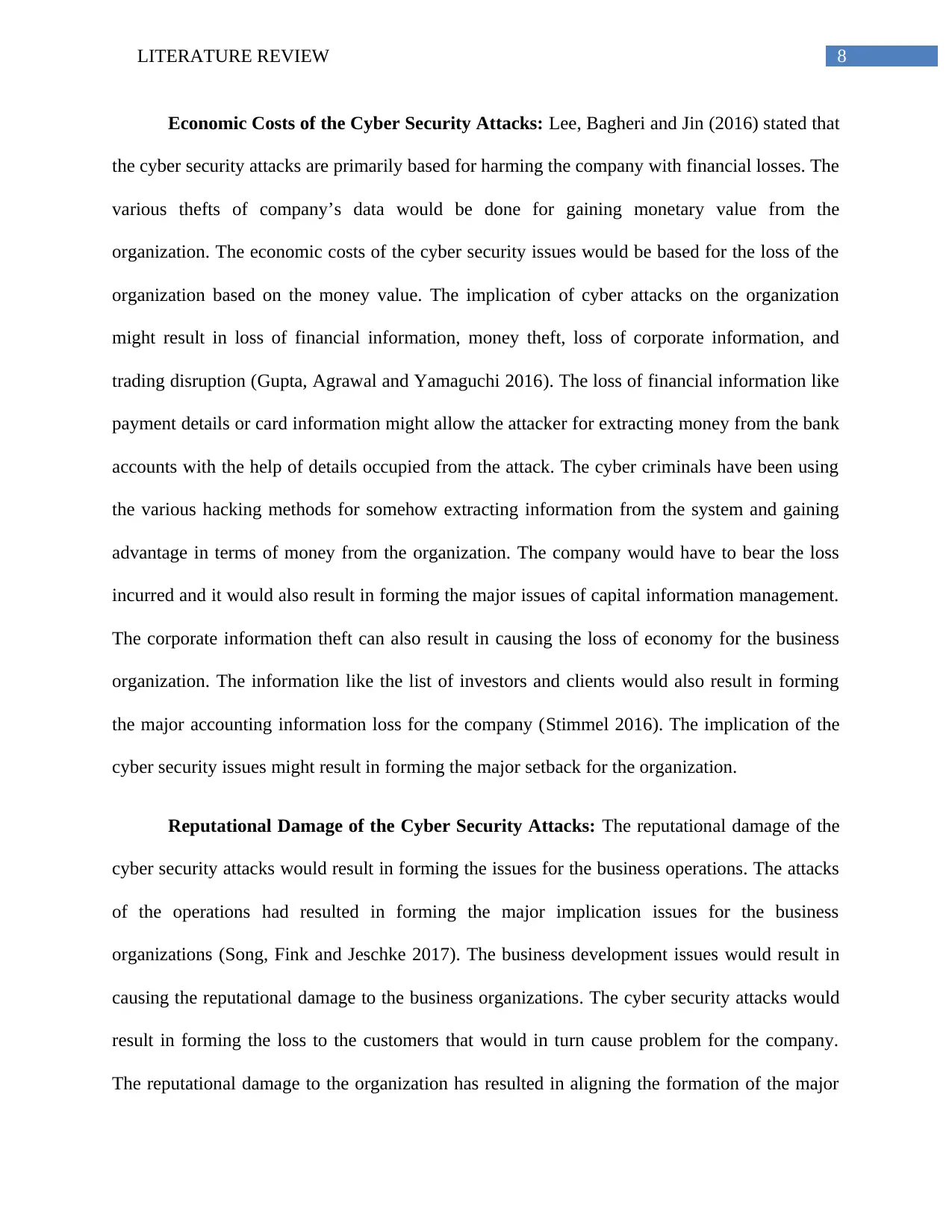
8LITERATURE REVIEW
Economic Costs of the Cyber Security Attacks: Lee, Bagheri and Jin (2016) stated that
the cyber security attacks are primarily based for harming the company with financial losses. The
various thefts of company’s data would be done for gaining monetary value from the
organization. The economic costs of the cyber security issues would be based for the loss of the
organization based on the money value. The implication of cyber attacks on the organization
might result in loss of financial information, money theft, loss of corporate information, and
trading disruption (Gupta, Agrawal and Yamaguchi 2016). The loss of financial information like
payment details or card information might allow the attacker for extracting money from the bank
accounts with the help of details occupied from the attack. The cyber criminals have been using
the various hacking methods for somehow extracting information from the system and gaining
advantage in terms of money from the organization. The company would have to bear the loss
incurred and it would also result in forming the major issues of capital information management.
The corporate information theft can also result in causing the loss of economy for the business
organization. The information like the list of investors and clients would also result in forming
the major accounting information loss for the company (Stimmel 2016). The implication of the
cyber security issues might result in forming the major setback for the organization.
Reputational Damage of the Cyber Security Attacks: The reputational damage of the
cyber security attacks would result in forming the issues for the business operations. The attacks
of the operations had resulted in forming the major implication issues for the business
organizations (Song, Fink and Jeschke 2017). The business development issues would result in
causing the reputational damage to the business organizations. The cyber security attacks would
result in forming the loss to the customers that would in turn cause problem for the company.
The reputational damage to the organization has resulted in aligning the formation of the major
Economic Costs of the Cyber Security Attacks: Lee, Bagheri and Jin (2016) stated that
the cyber security attacks are primarily based for harming the company with financial losses. The
various thefts of company’s data would be done for gaining monetary value from the
organization. The economic costs of the cyber security issues would be based for the loss of the
organization based on the money value. The implication of cyber attacks on the organization
might result in loss of financial information, money theft, loss of corporate information, and
trading disruption (Gupta, Agrawal and Yamaguchi 2016). The loss of financial information like
payment details or card information might allow the attacker for extracting money from the bank
accounts with the help of details occupied from the attack. The cyber criminals have been using
the various hacking methods for somehow extracting information from the system and gaining
advantage in terms of money from the organization. The company would have to bear the loss
incurred and it would also result in forming the major issues of capital information management.
The corporate information theft can also result in causing the loss of economy for the business
organization. The information like the list of investors and clients would also result in forming
the major accounting information loss for the company (Stimmel 2016). The implication of the
cyber security issues might result in forming the major setback for the organization.
Reputational Damage of the Cyber Security Attacks: The reputational damage of the
cyber security attacks would result in forming the issues for the business operations. The attacks
of the operations had resulted in forming the major implication issues for the business
organizations (Song, Fink and Jeschke 2017). The business development issues would result in
causing the reputational damage to the business organizations. The cyber security attacks would
result in forming the loss to the customers that would in turn cause problem for the company.
The reputational damage to the organization has resulted in aligning the formation of the major
⊘ This is a preview!⊘
Do you want full access?
Subscribe today to unlock all pages.

Trusted by 1+ million students worldwide
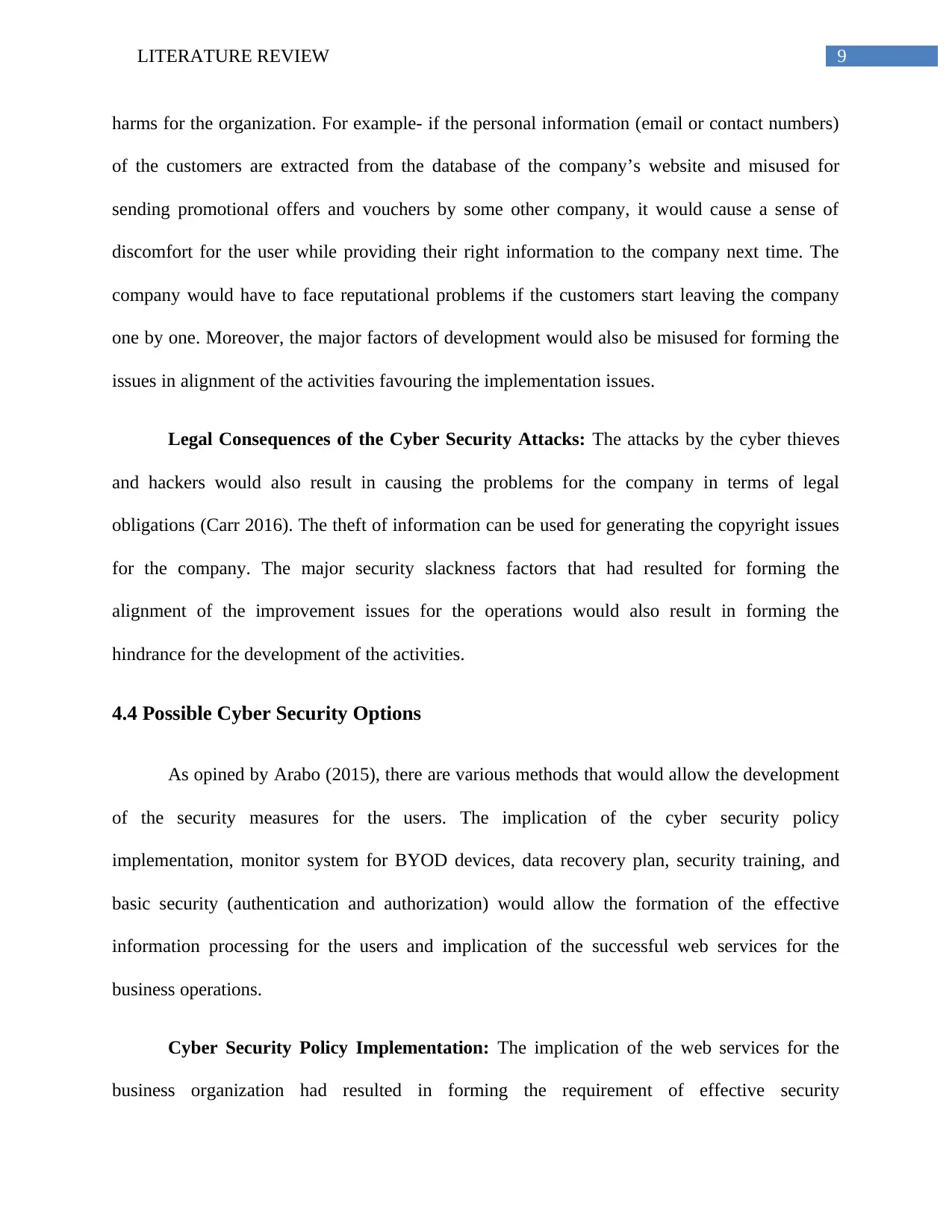
9LITERATURE REVIEW
harms for the organization. For example- if the personal information (email or contact numbers)
of the customers are extracted from the database of the company’s website and misused for
sending promotional offers and vouchers by some other company, it would cause a sense of
discomfort for the user while providing their right information to the company next time. The
company would have to face reputational problems if the customers start leaving the company
one by one. Moreover, the major factors of development would also be misused for forming the
issues in alignment of the activities favouring the implementation issues.
Legal Consequences of the Cyber Security Attacks: The attacks by the cyber thieves
and hackers would also result in causing the problems for the company in terms of legal
obligations (Carr 2016). The theft of information can be used for generating the copyright issues
for the company. The major security slackness factors that had resulted for forming the
alignment of the improvement issues for the operations would also result in forming the
hindrance for the development of the activities.
4.4 Possible Cyber Security Options
As opined by Arabo (2015), there are various methods that would allow the development
of the security measures for the users. The implication of the cyber security policy
implementation, monitor system for BYOD devices, data recovery plan, security training, and
basic security (authentication and authorization) would allow the formation of the effective
information processing for the users and implication of the successful web services for the
business operations.
Cyber Security Policy Implementation: The implication of the web services for the
business organization had resulted in forming the requirement of effective security
harms for the organization. For example- if the personal information (email or contact numbers)
of the customers are extracted from the database of the company’s website and misused for
sending promotional offers and vouchers by some other company, it would cause a sense of
discomfort for the user while providing their right information to the company next time. The
company would have to face reputational problems if the customers start leaving the company
one by one. Moreover, the major factors of development would also be misused for forming the
issues in alignment of the activities favouring the implementation issues.
Legal Consequences of the Cyber Security Attacks: The attacks by the cyber thieves
and hackers would also result in causing the problems for the company in terms of legal
obligations (Carr 2016). The theft of information can be used for generating the copyright issues
for the company. The major security slackness factors that had resulted for forming the
alignment of the improvement issues for the operations would also result in forming the
hindrance for the development of the activities.
4.4 Possible Cyber Security Options
As opined by Arabo (2015), there are various methods that would allow the development
of the security measures for the users. The implication of the cyber security policy
implementation, monitor system for BYOD devices, data recovery plan, security training, and
basic security (authentication and authorization) would allow the formation of the effective
information processing for the users and implication of the successful web services for the
business operations.
Cyber Security Policy Implementation: The implication of the web services for the
business organization had resulted in forming the requirement of effective security
Paraphrase This Document
Need a fresh take? Get an instant paraphrase of this document with our AI Paraphraser
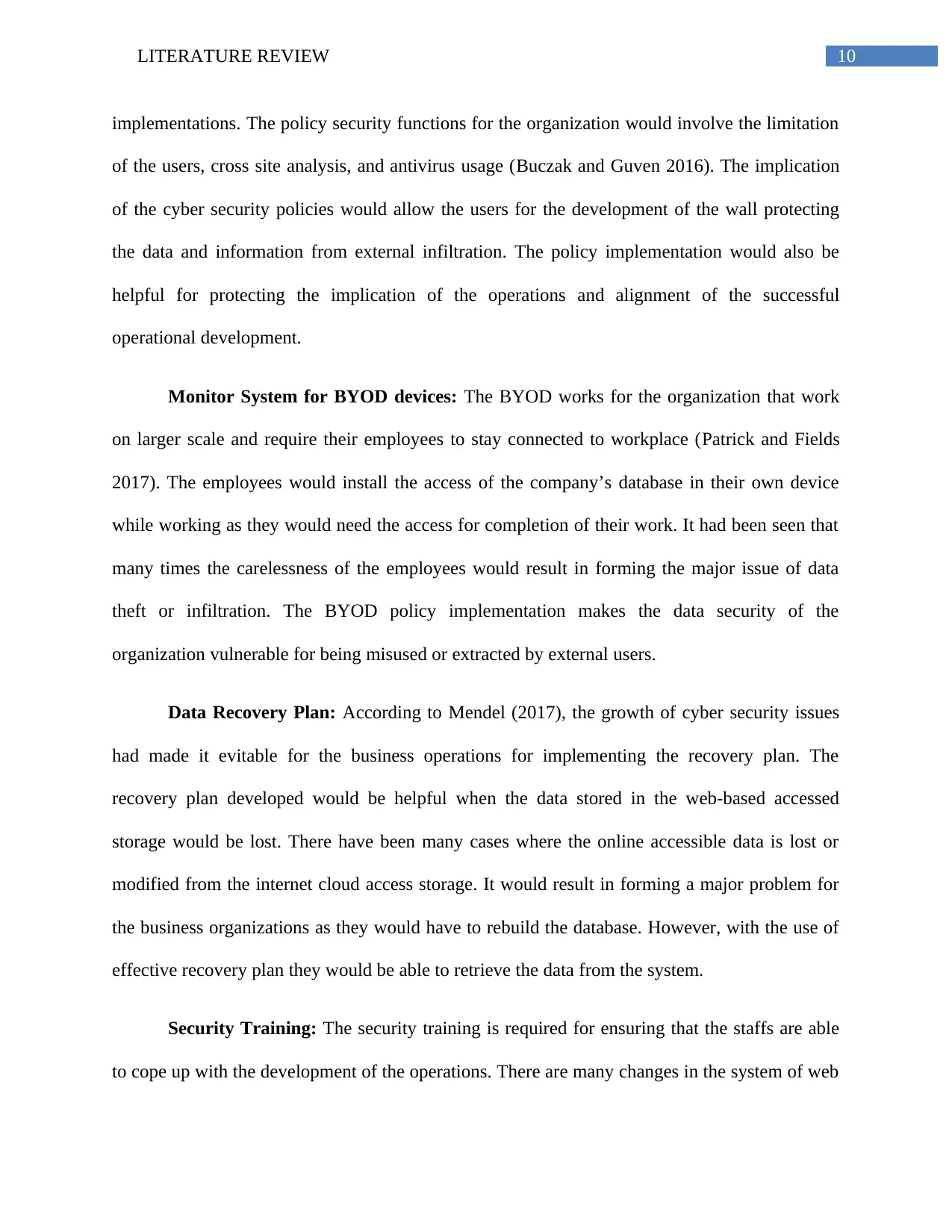
10LITERATURE REVIEW
implementations. The policy security functions for the organization would involve the limitation
of the users, cross site analysis, and antivirus usage (Buczak and Guven 2016). The implication
of the cyber security policies would allow the users for the development of the wall protecting
the data and information from external infiltration. The policy implementation would also be
helpful for protecting the implication of the operations and alignment of the successful
operational development.
Monitor System for BYOD devices: The BYOD works for the organization that work
on larger scale and require their employees to stay connected to workplace (Patrick and Fields
2017). The employees would install the access of the company’s database in their own device
while working as they would need the access for completion of their work. It had been seen that
many times the carelessness of the employees would result in forming the major issue of data
theft or infiltration. The BYOD policy implementation makes the data security of the
organization vulnerable for being misused or extracted by external users.
Data Recovery Plan: According to Mendel (2017), the growth of cyber security issues
had made it evitable for the business operations for implementing the recovery plan. The
recovery plan developed would be helpful when the data stored in the web-based accessed
storage would be lost. There have been many cases where the online accessible data is lost or
modified from the internet cloud access storage. It would result in forming a major problem for
the business organizations as they would have to rebuild the database. However, with the use of
effective recovery plan they would be able to retrieve the data from the system.
Security Training: The security training is required for ensuring that the staffs are able
to cope up with the development of the operations. There are many changes in the system of web
implementations. The policy security functions for the organization would involve the limitation
of the users, cross site analysis, and antivirus usage (Buczak and Guven 2016). The implication
of the cyber security policies would allow the users for the development of the wall protecting
the data and information from external infiltration. The policy implementation would also be
helpful for protecting the implication of the operations and alignment of the successful
operational development.
Monitor System for BYOD devices: The BYOD works for the organization that work
on larger scale and require their employees to stay connected to workplace (Patrick and Fields
2017). The employees would install the access of the company’s database in their own device
while working as they would need the access for completion of their work. It had been seen that
many times the carelessness of the employees would result in forming the major issue of data
theft or infiltration. The BYOD policy implementation makes the data security of the
organization vulnerable for being misused or extracted by external users.
Data Recovery Plan: According to Mendel (2017), the growth of cyber security issues
had made it evitable for the business operations for implementing the recovery plan. The
recovery plan developed would be helpful when the data stored in the web-based accessed
storage would be lost. There have been many cases where the online accessible data is lost or
modified from the internet cloud access storage. It would result in forming a major problem for
the business organizations as they would have to rebuild the database. However, with the use of
effective recovery plan they would be able to retrieve the data from the system.
Security Training: The security training is required for ensuring that the staffs are able
to cope up with the development of the operations. There are many changes in the system of web
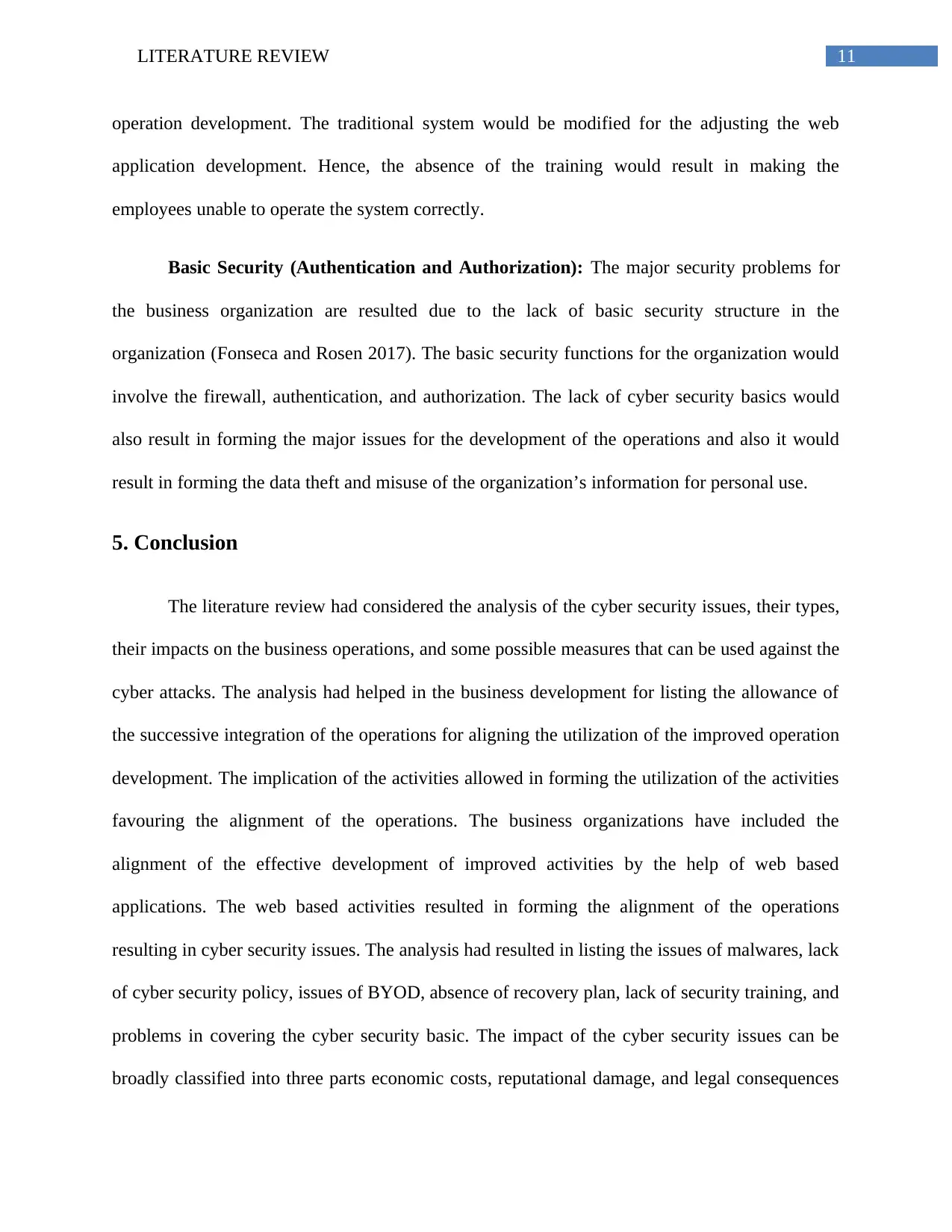
11LITERATURE REVIEW
operation development. The traditional system would be modified for the adjusting the web
application development. Hence, the absence of the training would result in making the
employees unable to operate the system correctly.
Basic Security (Authentication and Authorization): The major security problems for
the business organization are resulted due to the lack of basic security structure in the
organization (Fonseca and Rosen 2017). The basic security functions for the organization would
involve the firewall, authentication, and authorization. The lack of cyber security basics would
also result in forming the major issues for the development of the operations and also it would
result in forming the data theft and misuse of the organization’s information for personal use.
5. Conclusion
The literature review had considered the analysis of the cyber security issues, their types,
their impacts on the business operations, and some possible measures that can be used against the
cyber attacks. The analysis had helped in the business development for listing the allowance of
the successive integration of the operations for aligning the utilization of the improved operation
development. The implication of the activities allowed in forming the utilization of the activities
favouring the alignment of the operations. The business organizations have included the
alignment of the effective development of improved activities by the help of web based
applications. The web based activities resulted in forming the alignment of the operations
resulting in cyber security issues. The analysis had resulted in listing the issues of malwares, lack
of cyber security policy, issues of BYOD, absence of recovery plan, lack of security training, and
problems in covering the cyber security basic. The impact of the cyber security issues can be
broadly classified into three parts economic costs, reputational damage, and legal consequences
operation development. The traditional system would be modified for the adjusting the web
application development. Hence, the absence of the training would result in making the
employees unable to operate the system correctly.
Basic Security (Authentication and Authorization): The major security problems for
the business organization are resulted due to the lack of basic security structure in the
organization (Fonseca and Rosen 2017). The basic security functions for the organization would
involve the firewall, authentication, and authorization. The lack of cyber security basics would
also result in forming the major issues for the development of the operations and also it would
result in forming the data theft and misuse of the organization’s information for personal use.
5. Conclusion
The literature review had considered the analysis of the cyber security issues, their types,
their impacts on the business operations, and some possible measures that can be used against the
cyber attacks. The analysis had helped in the business development for listing the allowance of
the successive integration of the operations for aligning the utilization of the improved operation
development. The implication of the activities allowed in forming the utilization of the activities
favouring the alignment of the operations. The business organizations have included the
alignment of the effective development of improved activities by the help of web based
applications. The web based activities resulted in forming the alignment of the operations
resulting in cyber security issues. The analysis had resulted in listing the issues of malwares, lack
of cyber security policy, issues of BYOD, absence of recovery plan, lack of security training, and
problems in covering the cyber security basic. The impact of the cyber security issues can be
broadly classified into three parts economic costs, reputational damage, and legal consequences
⊘ This is a preview!⊘
Do you want full access?
Subscribe today to unlock all pages.

Trusted by 1+ million students worldwide
1 out of 16
Related Documents
Your All-in-One AI-Powered Toolkit for Academic Success.
+13062052269
info@desklib.com
Available 24*7 on WhatsApp / Email
![[object Object]](/_next/static/media/star-bottom.7253800d.svg)
Unlock your academic potential
Copyright © 2020–2025 A2Z Services. All Rights Reserved. Developed and managed by ZUCOL.




